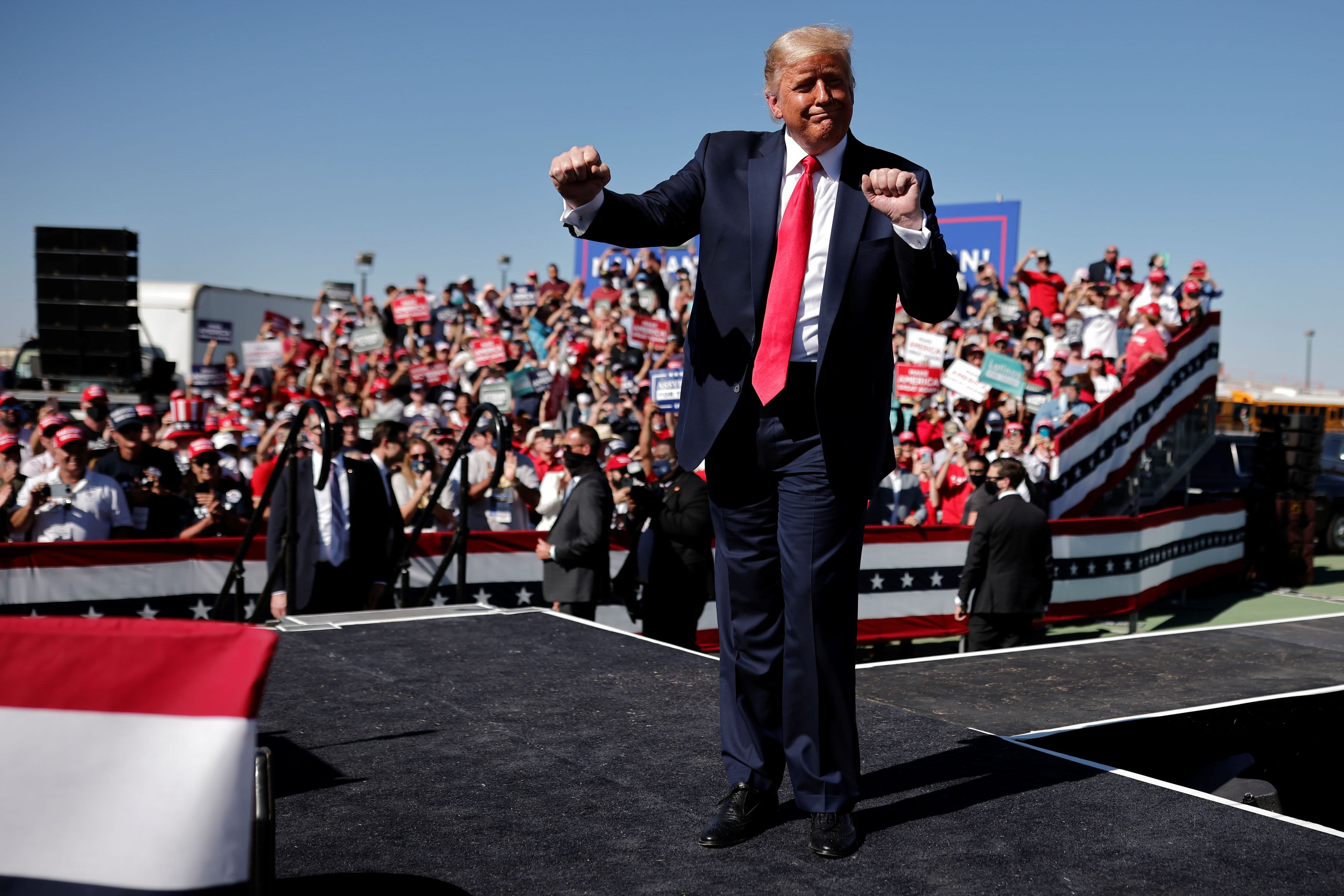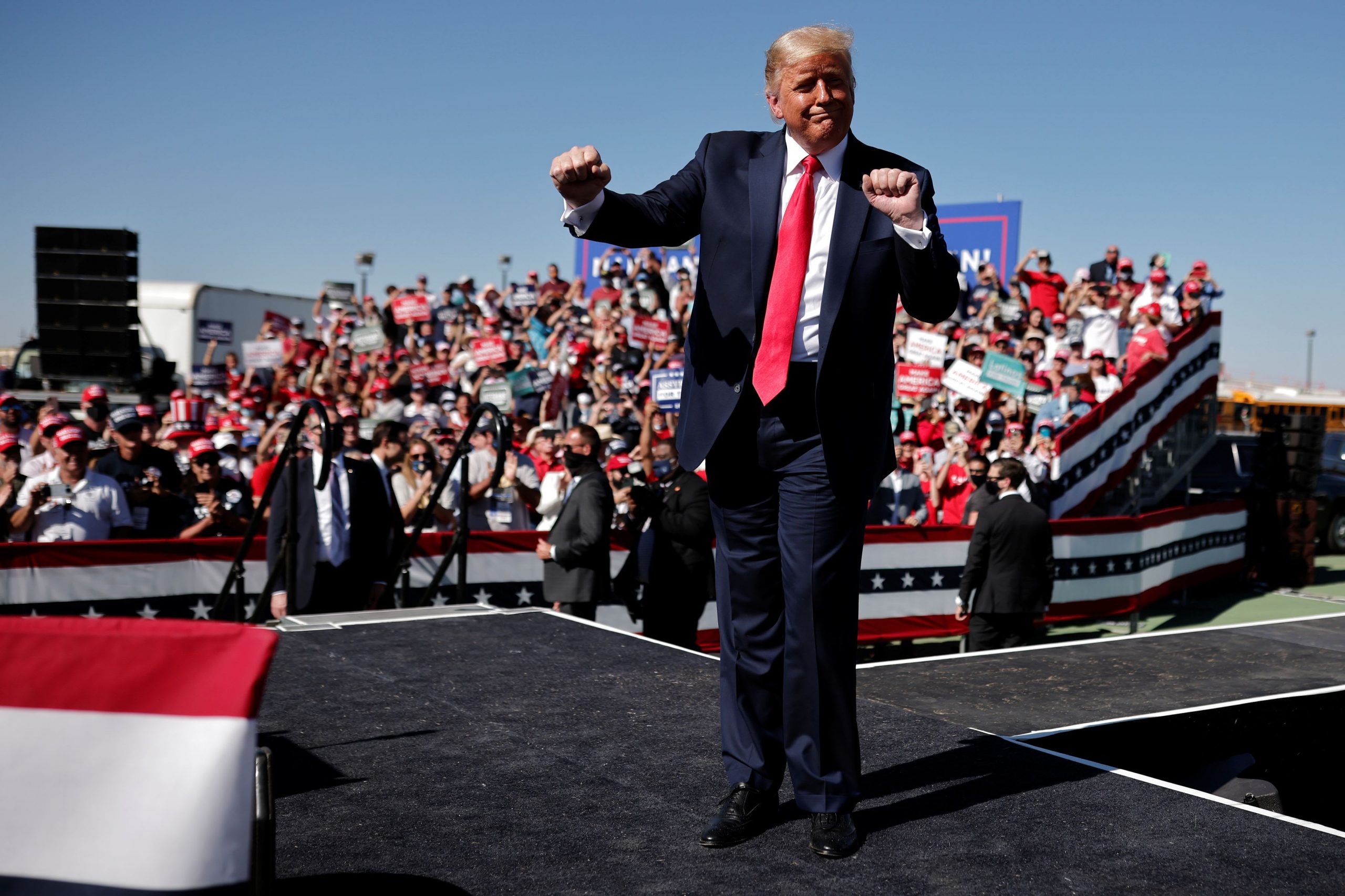
U.S. President Donald Trump gestures as he attends a campaign rally at Prescott Regional Airport, in Arizona, October 19, 2020.
Carlos Barria | Reuters
Next week, the U.S. will get economic news like it has never seen before, reflecting growth that had seemed impossible, as it is likely that GDP will have risen by about 30% or more.
In the middle of a pandemic. In the middle of a recession. In the middle of 12.5 million unemployed people.
While the incongruity of skyrocketing growth and extreme hardship will be impossible to ignore, it will come at an opportune time for President Donald Trump. The GDP release comes Oct. 29, just five days before the presidential election.
How seriously the country, and its voters, takes the news could influence what happens as the ballots are counted.
“Even though it’s totally meaningless, this is going to give Trump a little lift,” said Steve Blitz, chief U.S. economist at TS Lombard. “He’s going to say, ‘See, I told you, we have a ‘V’ [recovery] and we’re zooming.'”
The “zoom,” though, will be in completely relative terms.
The Commerce Department releases the gross domestic product report with a headline number that is calculated using a quarter-over-quarter gain stretched out over a yearly pace. So it’s not so hard to post what the Atlanta Fed forecasts will be a 35% gain in GDP when the base you’re working off is a 31.4% plunge in the second quarter, as the U.S. economy shut down large swaths of activity to defend against the coronavirus spread.
Still, the gains in activity have been remarkable.
The economy regained nearly 4 million jobs during the quarter, and that was after 7.5 million in May and June. Housing sales and builder confidence has been remarkable, and shoppers easily outpaced expectations in September with retail sales rising 1.9%, nearly tripling the Wall Street estimate.
Moreover, corporate executives remain confident.
The Conference Board’s CEO Confidence index, a gauge that measures the percent of positive responses on conditions, jumped to a reading of 64 in September from 45. A solid 70% of top executives said economic conditions were better compared with six months ago, compared with 8% at the start of the quarter. A similar number said conditions in their respective industries were better compared with six months ago, in the early days of the pandemic.
Moreover, 64% expect economic conditions to improve in the next six months, while only 15% see them worsening.
“CEOs entered Q4 significantly more upbeat than they were earlier this year,” said Dana Peterson, chief economist of The Conference Board. “Notably, talent shortages eased in the wake of COVID-19 and nearly two-thirds of business leaders said they anticipated little, if any, problems with attracting qualified workers. Nonetheless, uncertainty around the pandemic — and its aftermath — remains a risk to Q4’s newfound optimism as we enter 2021.”
Now comes the hard part
So with all those signs pointing up, what’s the problem?
The issue is what’s around the corner from that gaudy Q3 growth measure.
No one expects the economy to keep up that torrid pace, but there’s considerable unease over how long it truly will take conditions to get back to normal. Federal Reserve officials have said repeatedly that the return to the status quo or better is wholly dependent on the virus, but there remain substantial questions over how much permanent damage has been done.
“How do you keep all that momentum going? We all know you’re not going to get another 30% this quarter, and it’s going to drop down a lot,” Blitz said. “The potential level for GDP for the moment is capped at a lower level because you still have this impairment of activity due to the virus.”
The Fed’s official forecast for this year is GDP to decline 3.7%, which would be its biggest single-year drop going back through at least World War II. In 2021, the estimate is for a gain of 4%, which, conversely, would be the biggest increase since 2000.
Within that range lies a huge degree of uncertainty that would mitigate Trump’s claim on a strong economy heading out of the pandemic, whenever that comes. On the flip side, the growth could be stronger, should treatment of the virus continue to improve and a vaccine comes online, while Congress acts to provide more fiscal stimulus.
“On paper, [Q3 GDP] looks very strong, but I think it camouflages some of the underlying weakness that we still have,” said Deepak Puri, chief investment officer for the Americas at Deutsche Bank Wealth Management. “When you start to broaden that out you start seeing some of the industries that are still struggling. You could argue that it’s not a be-all end-all number. You are still looking at some parts of the economy that are severely damaged.”
From an investor perspective, Puri said uncertainty about the future, including the political landscape, is causing Deutsche to hold an underweight on U.S. stocks. A number of wild cards, such as regulatory uncertainty and the tax structure in case of a “blue wave” Democratic sweep, are sparking the cautious approach.
On the upside, expected infrastructure spending would benefit multiple sectors.
“Each outcome has its own risk/reward, but that’s more sector- and industry-specific,” Puri said.
From a broader perspective, the extent to which Trump can own an improving economy, or the virus-related conditions that led to the downturn, looms as a substantial factor in an election focused less on what has happened and more on where the road forward leads.
“The most optimistic forecasts are working on an assumption that there isn’t this permanent impairment of activity,” Blitz said.
“To say three years from now that this is all going to be a chapter in history, fair enough. I buy into that 100%, and I personally think that if we get to the point where everything is behind us, it’s going to be like the Roaring ’20s all over again,” he added. “But that’s not tomorrow and that’s not next week and that’s not next month. Is that a year from now? Two years from now? I don’t know, I can’t even begin to guess.”


 Signal2forex.com - Best Forex robots and signals
Signal2forex.com - Best Forex robots and signals




